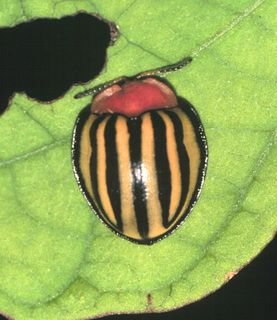Colorful insects help search for anti-cancer drugs
Colorful insects help search for anti-cancer drugs
mongabay.com
July 7, 2008
|
|
Brightly-colored beetles or caterpillars feeding on a tropical plant may signal the presence of chemical compounds active against cancer and parasitic diseases, report researchers writing in the journal Frontiers in Ecology and the Environment. The discovery could help speed drug discovery.
Scientists from the Smithsonian Tropical Research Institute (STRI) and other organizations collected beetles and caterpillars on plants that produce compounds with and without activity against various cancers and parasites. They found that insects showing warning coloration — bright colors and bold patterns — were significantly more common on plants that contained anti-cancer and anti-parasite compounds. There was no difference in abundance of plain-colored insects between plants with and without bioactivity.
 Colorful beetle may indicate useful plant chemicals. Credit: Don Windsor, STRI |
“We just put two and two together,” said Julie Helson, a student at McGill University when she did this work and now pursuing a PhD at the University of Toronto, “We knew that brightly colored insects advertise to their predators that they taste bad and that some of them get their toxins from their host plants, but because other insects cheat by mimicking the toxic ones, we weren’t sure if insect color was really going to work to identify plants containing toxins. It did!”
STRI says that the work supports the idea that “ecological and evolutionary theories about chemical defense in rainforest plants… can significantly improve the efficiency and lower the cost of drug discovery, when compared to a random screening approach.”
“Although the idea that brightly colored insects could facilitate the search for medicinally active plants has been discussed for decades, the concept had never been rigorously tested. Our new work suggests that a quick screen for insects with warning coloration on tropical plants may increase the efficiency of the search for compounds active against cancer and tropical parasitic disease by four-fold, another example of how ecology can contribute to the discovery of novel medicines. It’s very gratifying to see that it works in the field.” said Todd Capson, an Associate Scientist with STRI and a professor at McGill University who directed the project. “I am hopeful that other investigators will follow our lead and test our theory that insects can lead us to plants with disease fighting properties. Our work also demonstrates that the protection of tropical forests, not just the insects and plants, but at every level, has the potential to provide immeasurable benefits to human health.”
Funding for the study was provided by the U.S. National Institutes of Health, the U.S. National Science Foundation, the U.S. Department of Agriculture, the National Science and Engineering Research Council of Canada and a Levinson Fellowship from the STRI-McGill NEO program.
Julie E. Helson, Todd L. Capson, Timothy Johns, Annette Aiello and Donald M.Windsor. 2009. Ecologically and evolutionarily guided bioprospecting: the use of aposematic insects as potential guides to tropical rain forest plants with activity against disease. Front. Ecol. Environ. 7, doi:10.1890/070189.
This article is based on a news release from STRI